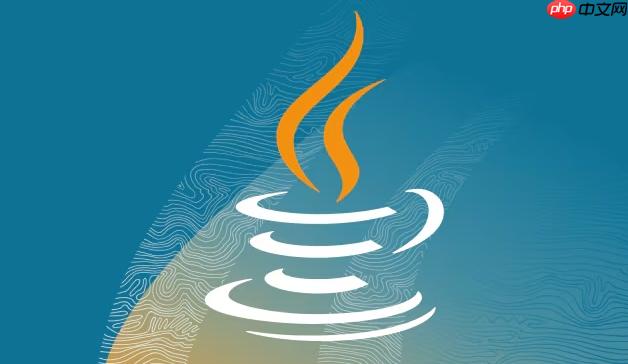Java中实现生产者消费者模式的核心是通过线程间通信协调共享缓冲区的访问,常用方法有三种:1. 使用synchronized配合wait()和notify()实现基础同步;2. 使用BlockingQueue如ArrayBlockingQueue,利用其内置阻塞机制简化开发;3. 使用Lock与Condition提供更灵活的多条件等待控制。其中BlockingQueue最推荐用于实际开发,而wait/notify和Lock/Condition更适合理解底层原理或定制场景。

在Java中实现生产者消费者模式,核心是让生产者线程向共享缓冲区添加数据,消费者线程从中取出数据,同时保证线程安全和避免资源浪费。关键在于线程间的协调与通信,常用方式包括使用 wait() 和 notify()、BlockingQueue 或 Lock 与 Condition。下面介绍几种典型实现方法。
定义一个共享的缓冲区(例如容量为1的队列):
class Buffer {
private int data;
private boolean isEmpty = true;
public synchronized void put(int value) {
while (!isEmpty) {
try {
wait(); // 缓冲区非空,生产者等待
} catch (InterruptedException e) {
Thread.currentThread().interrupt();
}
}
data = value;
isEmpty = false;
notify(); // 唤醒消费者
}
public synchronized int take() {
while (isEmpty) {
try {
wait(); // 缓冲区为空,消费者等待
} catch (InterruptedException e) {
Thread.currentThread().interrupt();
}
}
isEmpty = true;
notify(); // 唤醒生产者
return data;
}
}
生产者和消费者分别作为线程运行:
Buffer buffer = new Buffer();
Thread producer = new Thread(() -> {
for (int i = 0; i < 5; i++) {
buffer.put(i);
System.out.println("生产: " + i);
}
});
Thread consumer = new Thread(() -> {
for (int i = 0; i < 5; i++) {
int value = buffer.take();
System.out.println("消费: " + value);
}
});
producer.start();
consumer.start();
常见实现类有 ArrayBlockingQueue(有界队列)和 LinkedBlockingQueue(可选有界)。
立即学习“Java免费学习笔记(深入)”;
import java.util.concurrent.BlockingQueue;
import java.util.concurrent.ArrayBlockingQueue;
BlockingQueue<Integer> queue = new ArrayBlockingQueue<>(10);
Thread producer = new Thread(() -> {
for (int i = 0; i < 5; i++) {
try {
queue.put(i); // 队列满时自动阻塞
System.out.println("生产: " + i);
} catch (InterruptedException e) {
Thread.currentThread().interrupt();
}
}
});
Thread consumer = new Thread(() -> {
for (int i = 0; i < 5; i++) {
try {
Integer value = queue.take(); // 队列空时自动阻塞
System.out.println("消费: " + value);
} catch (InterruptedException e) {
Thread.currentThread().interrupt();
}
}
});
producer.start();
consumer.start();
import java.util.LinkedList;
import java.util.Queue;
import java.util.concurrent.locks.*;
class BufferWithLock {
private final Queue<Integer> queue = new LinkedList<>();
private final int MAX_SIZE = 10;
private final Lock lock = new ReentrantLock();
private final Condition notFull = lock.newCondition();
private final Condition notEmpty = lock.newCondition();
public void put(int value) throws InterruptedException {
lock.lock();
try {
while (queue.size() == MAX_SIZE) {
notFull.await(); // 队列满,等待
}
queue.offer(value);
notEmpty.signal(); // 唤醒消费者
} finally {
lock.unlock();
}
}
public int take() throws InterruptedException {
lock.lock();
try {
while (queue.isEmpty()) {
notEmpty.await(); // 队列空,等待
}
int value = queue.poll();
notFull.signal(); // 唤醒生产者
return value;
} finally {
lock.unlock();
}
}
}
使用方式与前面类似,创建线程调用 put 和 take 方法即可。
基本上就这些。BlockingQueue 是最简洁可靠的实现,适合大多数情况;而 wait/notify 和 Lock/Condition 更适合学习原理或定制逻辑。以上就是在Java中如何实现生产者消费者模式的详细内容,更多请关注php中文网其它相关文章!

每个人都需要一台速度更快、更稳定的 PC。随着时间的推移,垃圾文件、旧注册表数据和不必要的后台进程会占用资源并降低性能。幸运的是,许多工具可以让 Windows 保持平稳运行。

Copyright 2014-2025 https://www.php.cn/ All Rights Reserved | php.cn | 湘ICP备2023035733号